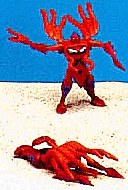 BEAST
WARS: TOY REVIEW
BEAST
WARS: TOY REVIEW
Name: SCUBA
Allegiance: Cybertron
Function: Marine Construction
Beast Mode: Squid
Average Price: 750 JPY

BEAST MODE
Length: 15 cm
It's bland, it's boring, it's an orange and maroon squid
with light purple spots. Well... I suppose there's not much you could expect
a toy squid to do. The arms and tentacles offer a total of 6 points of
articulation. In the centre of the tentacles is a mouth gimmick which is
activated by pressing a lever behind the head. By doing so, two radula
come out from either side of the beak. Oooh, scary.
TRANSFORMATION
The top part of the head splits in two to become the legs/feet.
Lift the mantle up and rotate the legs 180 degrees (this is the part that
looks really cool in the show). If you haven't already done so by now,
turn the toy upside down and pivot the rear arms to the sides to reveal
robot head. Lift up robot head and turn it 180 degrees. Lower the two remaining
tentacles.
ROBOT MODE
Height: 10cm
Points of Articulation: 12 (disincluding tentacles)
I must agree with Ben Yee on the point that this toy
really does look a tad too organic in robot mode, especially the head.
The only remotely mecha-looking part is the chest and thighs. After reading
Ben's review and looking at several pictures of the toy, I was quite skeptic
at buying this toy. In fact, I only bought it because Scuba happens to
be one of my favourite characters in the Beast Wars II series. However,
I must confess that I was pleasantly surprised after purchasing and opening
the toy. Despite its shortcomings, it's really not that bad a toy. But
the lack of hands kinda erks me. I don't like handless humanoid robots.
Also, he lacks a decent weapon. The only weapon he comes with is this 32mm
V-shaped object which resemble a pair of barbeque tongs. According to the
instructions, it's supposed to be a claw. Whatever. The radula gimmick,
located in the chest, is activated by pushing a lever on the back (note
that unlike Claw Jaw's instructions, which neglects to mention this gimmick,
Scuba's instruction clearly illustrates this gimmick; this is an all-too-typical
case of Japanese instructions being surpassing the American ones,
not to mention they're drawn much better, but I digress...).
Due to it's incredibly short range, this weapon could
only be used at close distance. The rear tentacles protrude from the shoulders
and they look pretty neat, sticking out like 'wings'. The two arms located
beneath the breast (where the pincers come out from) interferes with the
legs.
RUB STICKER LOCATION
On the right rear arms (underside).
OVERALL
If I'd never seen Beast Wars II, I don't think I would've
bought this toy. Even then it was a bit of an impulse buy (I also bought
this toy from a specialty store here... heaven forbid that I actually went
to all the trouble of ordering and having it sent from Japan!). Oh heck,
the toy sucks. Sure, it doesn't suck as bad as I thought it would suck,
but it still sucks (it's a Dustbuster where I was expecting a Hoover).
BEAST TRIVIA
Both octopi and squids belong to the group known as Cephalopods. This group
includes cuttlefish and nautili. The name Cephalopod means "head-foot",
a tribute to the creature's unusual body design. Squids and cuttlefish
have eight arms and two tentacles (whereas Octopi have only eight arms
and no tentacles). The tentacles are much longer than the arms and are
used to grab prey.
Arms and tentacles protrude from the head and are actually overdeveloped
lips. In the centre of the arms and tentacles is a mouth with a beak and
a rough tongue known as the radula. The radula is like the tip of a chainsaw
with rasping pegs on it like sawteeth. This is used to wear down hard materials.
Behind the head is a muscular bag known as the mantle. This contains the
remainder of the body's organs, including three hearts, the digestive system
and the gills.
Water is drawn into the mantle via a wide slit known as the mantle aperture.
The water carries dissolved oxygen to the gills. After the gills have extracted
the oxygen, the water is expelled through a funnel. The mantle can also
be suddenly squeezed to push out water with great force, propelling the
animal in the opposite direction. The funnel can be moved to steer in different
directions.
Squids are the fastest "flyers" among all Cephalopods. The move in fast
accurate motions, in contrast to their slow bottom dwelling octopi cousins.
Bibliography: Australian
Broadcasting Corporation.
Email
Back
 BEAST
WARS: TOY REVIEW
BEAST
WARS: TOY REVIEW